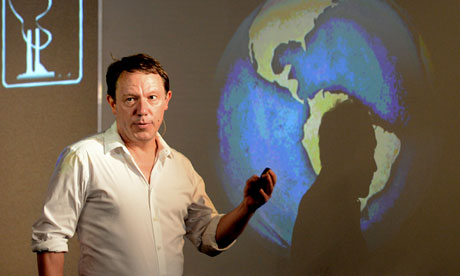Stephen Emmott's population book is unscientific and misanthropic

Stephen Emmott performs during a rehearsal of the play Ten Billion, a collaboration with theatremaker Katie Mitchell Photograph: Boris Horvat/AFP/Getty Images
Stephen Emmott's book on global ecological challenges is attracting much attention. The work is extremely short – perhaps about 15,000 words – and is in the form of notes that provide terse commentary on a series of graphs. It is little more than a Powerpoint presentation turned into a slim paperback. Although any attempt to increase mankind's alarm at the threat from climate change is welcome, Emmott's book is error-strewn, full of careless exaggeration and weak on basic science. Its reliance on random facts pulled from the internet is truly shocking and it will harm the cause of environmental protection. As might be expected, the best sceptic bloggers are already deconstructing its excesses line-by-line.
Things are indeed pretty bad. The steps to address climate change are lamentably slow and ineffectual. Biodiversity is in sharp decline in some parts of the world. Water supplies are becoming tighter in many countries. The pressures on global forests are declining but still acute in some places. Air quality is appalling in big cities in Asia and quite bad in major Western capitals. But we don't help solve these problems by exaggerating their seriousness and picking up gobbets of data from dodgy sources we found on the web
All of us see these difficult problems but most see them as soluble. Not so Stephen Emmott. In his eyes the world is hurtling towards disaster at ever-increasing speed. To him, every global issue is of 'accelerating' seriousness. At one point the word 'accelerates' is used 8 times in just over 100 words to describe a tip into some future hell. (It's also striking that a senior scientist uses this word inexactly. He generally doesn't mean that the rate of change is increasing but merely that the particular phenomenon he is worried about is continuing to grow).
Emmott starts by looking at population from the year 10,000 BC. He says he uses data from the UN but I cannot find anything produced by this organisation that records estimates prior to 1950. He seems instead to have employed a file found on the internet athttp://commons.wikimedia.org/wiki/File:Population_curve.svg. This file has the unusual features of Emmott's first chart, such as the use of a year called 'AD1'. He uses the curve of population growth to tell us we might see a fourfold increase in population by 2100.
Despite Emmott's assertions to the contrary, population growth has been slowing steadily since the 1960's. The number of people in the world is increasing by about 1% a year and the slowdown will almost certainly continue. This is never mentioned, let alone discussed by Emmott. Reasonable 2050 predictions are almost all in the 9 to 10 billion range, with most people seeing declines after that date but he tells us that we might actually see 28 billion by 2100. Does he have an argument why his number could be right? No, he just asserts it.
Similarly, he addresses food supply with passionate language and few facts. He ignores the relatively stable and gradual increases in food availability per person over the last half-century and predicts coming apocalypse. A huge increase in land needed for food production is forecast, something completely unpredicted by any experts in the field. He reserves particular scorn for the impact of improved agricultural technologies such as pesticides and fertilisers. 'The Green Revolution is a myth' he writes, ignoring the extraordinary and reliable increase in food production launched by the plant breeder Norman Borlaug in India that made famine thankfully rare. His assessments of the need for more land on which to grow crops seem to crudely assume no increase whatsoever in yields per hectare, ignoring reliable evidence since the 1960s.
Very strangely, I don't think any of of the thirteen apocalyptic charts in his book are taken from primary sources. The data he uses is almost always 'adapted' from other work, something which doesn't appear to embarrass him. The figures employed aren't traceable and checking is difficult. But those charts that I was able to source are generally mis-drawn or downright misleading. For example, the worrying chart on species extinction on page 54 of the Kindle edition seems to present a sharp, abrupt and catastrophic rise from the year 2045 without any basis in fact or scientific research. Others are similarly invented.
When it comes to discussion of fish production, Emmott shows an equally disturbing lack of knowledge. He writes that a 'fully exploited' fishing ground has 'no fish left'. Actually, the words mean that the rate of fish extraction cannot be increased without loss of long term fish extraction potential.
He's also worried about water availability. And this is indeed going to be one of the world's most pressing problems by 2050. But he exaggerates, as in so many other instances, the current seriousness of the issue. Several of his very sparsely filled pages are given over to discussing how much water is needed to grow food but nowhere does he discuss the global availability. Yes, the world does use 6,000 cubic kilometres of fresh water a year but we probably have about twenty times this much available in one form or another. Small improvements in irrigation practices will almost certainly help us decrease water stress in the most threatened global food production areas. I'm not trying to diminish the severity of the challenge but to ask Emmott to give us careful argument, not overplayed assertion.
Although I think that most of what he says on other subjects is ill-researched, most of the readers of this blog will agree strongly with his views on climate change. He exaggerates the likely increase in global energy need – a few well researched charts from the recent BP statistical review would have helped him – but we do face a real likelihood of a 4 degree temperature rise on current trends. Emmott is right to emphasise the weak global response to this threat.
He's not a fan of renewable energy sources but his opinions are surprisingly casual. PV, for example, is flawed because 'the production of the new generation of solar panels involves nitrogen triflouride (sic) – one of the most potent greenhouse gases on earth'. Nowhere does he tell us that this molecule has been used for years and that when calculations have been done, the carbon benefit of the renewable electricity generated by the panel dwarfs the global warming impact of the nitrogen trifluoride used. This is typical of the book: lots of strong assertions, no analysis and lots of factual mistakes.
In the end, his ambivalent feelings towards humanity come out all too clearly. Every which way you look at it, a planet of ten billion looks like a nightmare, he writes. I wanted him to come up with solutions to humanity's problems, not to exhibit a troubling misanthropism and astonishingly careless use of data and basic science.
________
Obs: Um pequeno livro que diz algumas verdades, exagera outro tanto e já está envolto em alguma polémica.
Etiquetas: global ecological challenges, population, Stephen Emmott's




<< Home